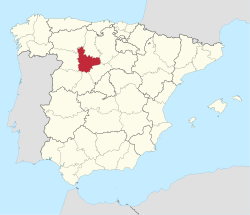
Back Provincia de Valladolit AN بلد الوليد (مقاطعة) Arabic Provincia de Valladolid AST وایادولید اوستانی AZB Вальядалід (правінцыя) Byelorussian Proviñs Valladolid Breton Província de Valladolid Catalan Provincia de Valladolid CEB Provincie Valladolid Czech Valladolid (provins) Danish
This article may require copy editing for unencyclopedic language. (May 2024) |
Valladolid | |
|---|---|
       From top to bottom and from left to right: The Castle of Peñafiel, Canal of Castile, typical landscape of the province, a pine forest, center of a Castilian town, Castle of La Mota and a wine cellar. | |
 Map of Spain with Valladolid highlighted | |
| Coordinates: 41°35′N 4°40′W / 41.583°N 4.667°W | |
| Country | Spain |
| Autonomous community | Castile and León |
| Capital | Valladolid |
| Area | |
| • Total | 8,110 km2 (3,130 sq mi) |
| • Rank | Ranked 28th |
| 1.61% of Spain | |
| Population (2021) | |
| • Total | 521,333 |
| • Rank | Ranked 29th |
| • Density | 64/km2 (170/sq mi) |
| 1.11% of Spain | |
| Demonym | Spanish: Vallisoletano/a |
| ISO 3166 code | ES-VA |
| Official language(s) | Spanish |
| Parliament | Cortes Generales |
| Website | diputaciondevalladolid.es |
Valladolid (Spanish: [baʎaðoˈlið] ) is a province of northwest Spain, in the central part of the autonomous community of Castile and León. It has a population of 521,333 people in a total of 225 municipalities, an area of 8,110 km2 (3,130 sq mi) and a population density of 64.27 people per km2.
The capital is the city of Valladolid. It is bordered by the provinces of Zamora, León, Palencia, Burgos, Segovia, Ávila, and Salamanca. It is thus the only Spanish province surrounded entirely by other provinces of the same autonomous community. It is the only peninsular province which has no mountains.[1]
Because the extensive plain on which the province lies is important to overland transport, it is a major communications hub. From a national point of view it connects Madrid with the north of Spain, from Vigo in Galicia to San Sebastián in the Basque Country, and from an international point of view, it is on the shortest land route connecting Porto in the north of Portugal with Hendaye in the south of France.
The cuisine of the province is like that of Castile—meats and roasts occupy a central place. One of the most typical dishes is lechazo, a dish made from unweaned lambs, similar to veal. Suckling pig, black pudding, sausages and sheep's milk cheeses and breads are also traditional. The province has five wines with a denomination of origin.
The province once served as the capital of the Castilian court and the former capital of the Empire during the reigns of Emperor Carlos I, Philip II and Philip III, which explains why to this day it remains pregnant with castles and strongholds. The capital has an important historical – artistic heritage and one of the more important museums of sculpture of Europe. The province of Valladolid is specially recognized for its processions of Holy Week, as much in the capital as in the localities of Medina de Rioseco and Medina del Campo. In addition, the province has two UNESCO world heritage sites within its category Memory of the World Programme: the Treaty of Tordesillas and the Archivo General de Simancas.

